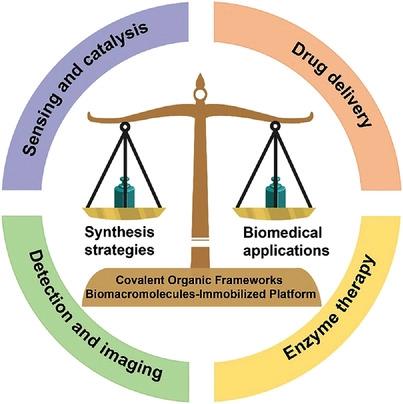当前位置:
X-MOL 学术
›
Adv. Therap.
›
论文详情
Our official English website, www.x-mol.net, welcomes your feedback! (Note: you will need to create a separate account there.)
Covalent Organic Frameworks as a Biomacromolecule Immobilization Platform for Biomedical and Related Applications
Advanced Therapeutics ( IF 4.6 ) Pub Date : 2022-07-15 , DOI: 10.1002/adtp.202200053 Xinyue Wang 1 , Damani A. Lewis 1 , Gang Wang 2 , Tao Meng 1 , Shengnan Zhou 1 , Yuheng Zhu 1 , Danyou Hu 1 , Shan Gao 1 , Guiyang Zhang 1
Advanced Therapeutics ( IF 4.6 ) Pub Date : 2022-07-15 , DOI: 10.1002/adtp.202200053 Xinyue Wang 1 , Damani A. Lewis 1 , Gang Wang 2 , Tao Meng 1 , Shengnan Zhou 1 , Yuheng Zhu 1 , Danyou Hu 1 , Shan Gao 1 , Guiyang Zhang 1
Affiliation

|
With the development of biotherapeutic field, biomacromolecules with definite curative and small side effects have gradually become a hot spot in the research and development of new drugs. However, the use of biomacromolecules as drug candidates pose some technical difficulties related to their medicinal properties, mainly drug stability and in vivo transport and delivery. Currently, diverse nanodrug delivery systems have been used to deliver biomacromolecules because they can maintain stability, significantly increase bioavailability, and improve targeted distribution of biomacromolecules, thereby improving efficacy and reducing toxicity. In recent years, covalent organic frameworks (COFs) have attracted increasing interest as stable, efficient, and reusable biomacromolecule immobilization carriers. COFs exhibit good stability and biocompatibility with no biological toxicity, making them outstanding host materials for immobilizing biomacromolecules. However, the synthesis of COFs requires severe experimental conditions; the commonly used strategies for immobilizing biomacromolecules in metal–organic frameworks (MOFs), such as biomimetic mineralization, one-pot synthesis, and coprecipitation, are likely not applicable to COFs. Herein, three strategies for immobilizing biomacromolecules in COFs and the multifunctional biomedical applications of the biomacromolecule@COF composite systems are reviewed. Next, the superior properties and cutting-edge applications of MOFs are mentioned and then the advantages of COF–MOF hybrid materials are highlighted.
中文翻译:

共价有机框架作为生物医学和相关应用的生物大分子固定化平台
随着生物治疗领域的发展,疗效确切、副作用小的生物大分子逐渐成为新药研发的热点。然而,使用生物大分子作为候选药物会带来一些与其药用特性相关的技术困难,主要是药物稳定性和体内转运和递送。目前,多种纳米药物递送系统已被用于递送生物大分子,因为它们可以保持稳定性,显着提高生物利用度,并改善生物大分子的靶向分布,从而提高疗效并降低毒性。近年来,共价有机框架(COFs)作为稳定、高效、可重复使用的生物大分子固定化载体引起了越来越多的关注。COFs表现出良好的稳定性和生物相容性,无生物毒性,使其成为固定生物大分子的出色宿主材料。然而,COFs 的合成需要严格的实验条件;将生物大分子固定在金属有机框架 (MOF) 中的常用策略,例如仿生矿化、一锅合成和共沉淀,可能不适用于 COF。本文综述了将生物大分子固定在 COF 中的三种策略以及生物大分子@COF 复合系统的多功能生物医学应用。接下来,介绍了MOFs的优越性能和前沿应用,然后重点介绍了COF-MOF杂化材料的优势。使它们成为固定生物大分子的出色宿主材料。然而,COFs 的合成需要严格的实验条件;将生物大分子固定在金属有机框架 (MOF) 中的常用策略,例如仿生矿化、一锅合成和共沉淀,可能不适用于 COF。本文综述了将生物大分子固定在 COF 中的三种策略以及生物大分子@COF 复合系统的多功能生物医学应用。接下来,介绍了MOFs的优越性能和前沿应用,然后重点介绍了COF-MOF杂化材料的优势。使它们成为固定生物大分子的出色宿主材料。然而,COFs 的合成需要严格的实验条件;将生物大分子固定在金属有机框架 (MOF) 中的常用策略,例如仿生矿化、一锅合成和共沉淀,可能不适用于 COF。本文综述了将生物大分子固定在 COF 中的三种策略以及生物大分子@COF 复合系统的多功能生物医学应用。接下来,介绍了MOFs的优越性能和前沿应用,然后重点介绍了COF-MOF杂化材料的优势。将生物大分子固定在金属有机框架 (MOF) 中的常用策略,例如仿生矿化、一锅合成和共沉淀,可能不适用于 COF。本文综述了将生物大分子固定在 COF 中的三种策略以及生物大分子@COF 复合系统的多功能生物医学应用。接下来,介绍了MOFs的优越性能和前沿应用,然后重点介绍了COF-MOF杂化材料的优势。将生物大分子固定在金属有机框架 (MOF) 中的常用策略,例如仿生矿化、一锅合成和共沉淀,可能不适用于 COF。本文综述了将生物大分子固定在 COF 中的三种策略以及生物大分子@COF 复合系统的多功能生物医学应用。接下来,介绍了MOFs的优越性能和前沿应用,然后重点介绍了COF-MOF杂化材料的优势。
更新日期:2022-07-15
中文翻译:

共价有机框架作为生物医学和相关应用的生物大分子固定化平台
随着生物治疗领域的发展,疗效确切、副作用小的生物大分子逐渐成为新药研发的热点。然而,使用生物大分子作为候选药物会带来一些与其药用特性相关的技术困难,主要是药物稳定性和体内转运和递送。目前,多种纳米药物递送系统已被用于递送生物大分子,因为它们可以保持稳定性,显着提高生物利用度,并改善生物大分子的靶向分布,从而提高疗效并降低毒性。近年来,共价有机框架(COFs)作为稳定、高效、可重复使用的生物大分子固定化载体引起了越来越多的关注。COFs表现出良好的稳定性和生物相容性,无生物毒性,使其成为固定生物大分子的出色宿主材料。然而,COFs 的合成需要严格的实验条件;将生物大分子固定在金属有机框架 (MOF) 中的常用策略,例如仿生矿化、一锅合成和共沉淀,可能不适用于 COF。本文综述了将生物大分子固定在 COF 中的三种策略以及生物大分子@COF 复合系统的多功能生物医学应用。接下来,介绍了MOFs的优越性能和前沿应用,然后重点介绍了COF-MOF杂化材料的优势。使它们成为固定生物大分子的出色宿主材料。然而,COFs 的合成需要严格的实验条件;将生物大分子固定在金属有机框架 (MOF) 中的常用策略,例如仿生矿化、一锅合成和共沉淀,可能不适用于 COF。本文综述了将生物大分子固定在 COF 中的三种策略以及生物大分子@COF 复合系统的多功能生物医学应用。接下来,介绍了MOFs的优越性能和前沿应用,然后重点介绍了COF-MOF杂化材料的优势。使它们成为固定生物大分子的出色宿主材料。然而,COFs 的合成需要严格的实验条件;将生物大分子固定在金属有机框架 (MOF) 中的常用策略,例如仿生矿化、一锅合成和共沉淀,可能不适用于 COF。本文综述了将生物大分子固定在 COF 中的三种策略以及生物大分子@COF 复合系统的多功能生物医学应用。接下来,介绍了MOFs的优越性能和前沿应用,然后重点介绍了COF-MOF杂化材料的优势。将生物大分子固定在金属有机框架 (MOF) 中的常用策略,例如仿生矿化、一锅合成和共沉淀,可能不适用于 COF。本文综述了将生物大分子固定在 COF 中的三种策略以及生物大分子@COF 复合系统的多功能生物医学应用。接下来,介绍了MOFs的优越性能和前沿应用,然后重点介绍了COF-MOF杂化材料的优势。将生物大分子固定在金属有机框架 (MOF) 中的常用策略,例如仿生矿化、一锅合成和共沉淀,可能不适用于 COF。本文综述了将生物大分子固定在 COF 中的三种策略以及生物大分子@COF 复合系统的多功能生物医学应用。接下来,介绍了MOFs的优越性能和前沿应用,然后重点介绍了COF-MOF杂化材料的优势。



























 京公网安备 11010802027423号
京公网安备 11010802027423号